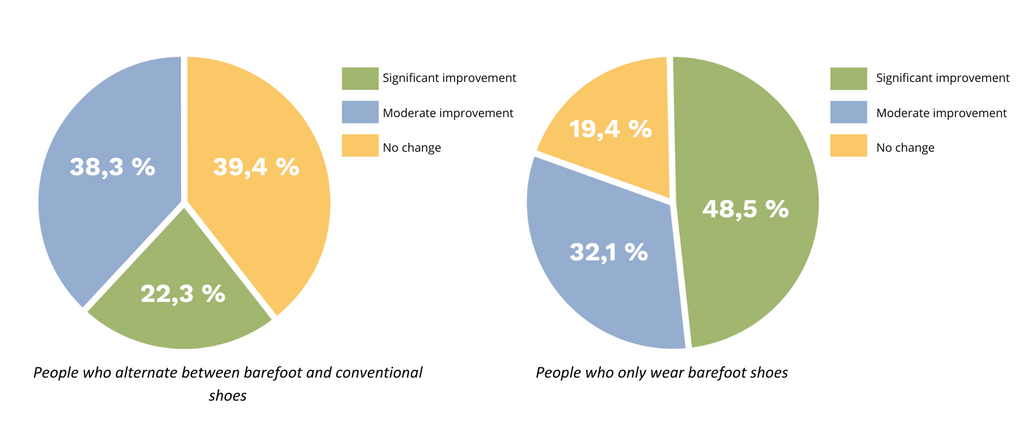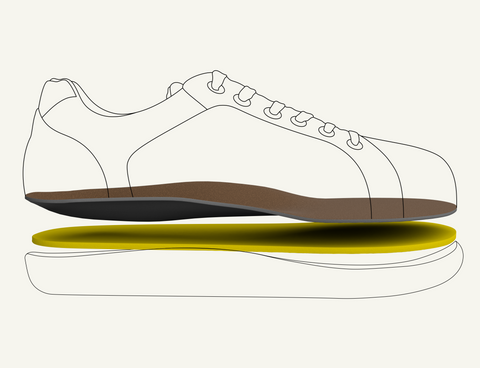Barefoot & the City: What Everyone Who Walks on Concrete Should Know
You might be surprised, but it is. You can wear barefoot shoes even in the city. However, you need to know how to walk in them without harming yourself. How to do it - and what if you want to avoid learning sensitive walking? We'll advise you in today's article.
To begin with: Barefoot shoes are not just shoes with thin soles. Good barefoot shoes are also recognizable by zero-drop heel, wide toe-box, and flexible materials.

Zero-drop heel, wide toe-box, flexible materials. That's how you can recognize healthy shoes for the city (and anywhere else).
Walking barefoot on asphalt: What's the problem?
Bare feet are the happiest in nature – where the surface is soft and varied. In the city, they encounter the exact opposite: hard and uninteresting flat surfaces.
But did you know that's not entirely true? Walking barefoot on city asphalt and concrete isn't boring.
"Take off your shoes and walk barefoot in the city. You'll see that hardly anywhere is the surface flat and homogeneous," says physiotherapist Zuzana Kejíková.

Stairs, cobblestones, curbs. Even in the city, your feet stay engaged.
In urban settings, your feet encounter various stimuli. Curbs, cobblestones, tactile paving for the visually impaired. On your way to work, you explore the world through your feet, if your shoes allow it. The challenge comes with walking on hard surfaces.
"In the city, I perceive the issue of hardness because many people who wear barefoot shoes in the city don't know how to walk healthily," adds Zuzana Kejíková.
When we walk healthily, concrete doesn't bother us. But we're not used to it.
A healthy foot accustomed to natural walking copes well with hard surfaces. The toes and arch cushion the step, allowing us to tread softly even on concrete.
"Those accustomed to barefoot walking can use walking on asphalt as training. The less natural the environment, the more it can strengthen and activate us. However, the prerequisite is the correct walking technique," says physiotherapist Lukáš Klimpera.

So, what's the catch? Most of us don't walk naturally. From an early age, we wear stiff and narrow shoes that teach us a different way of walking. We land heavily on our heels, creating an impact that spreads through the body, endangering everything from the heels to the knees and back.
Professor Daniel Lieberman describes the impact on the heel in people accustomed to regular shoes as a "hammer blow." However, he found that people accustomed to barefoot walking don't experience this impact, thus protecting their joints.
How do I know if I'm walking healthily?
In the city, we must walk healthily and sensitively to avoid injury. But how can we tell? Try a simple test. Next time you walk in the city, put on your headphones. Don't play music, just listen.
Do you hear thumping?
If you do, it means you're stomping, walking heavily, and hurting yourself. When walking healthily, we place our feet down gently to avoid impacting the heel. A gentle step makes no sound.
How to train for healthy walking? Download the free e-book Step by Step to Healthy Walking.

In healthy walking, we place our feet down gently. There's no thumping.
Are barefoot shoes really that healthy? Here's what studies and our research say.
You might wonder if barefoot shoes are worth it. Why wear them when you first have to learn to walk healthily?
Several studies speak in their favor. For example:
- Daily walking in minimalist footwear increases foot strength. A study from September 2021 showed that people who wore barefoot shoes for 6 months experienced a 57.4% increase in foot strength.
- Toddlers should wear barefoot shoes. A Czech study from 2022 followed 30 toddlers. Half wore traditional shoes, and half wore barefoot shoes. Researchers observed healthier foot development in the barefoot group, such as higher arches.
- Runners in barefoot shoes gained strength. A study from 2019 monitored runners who wore barefoot shoes for running. Those who ran longer distances in minimalist shoes strengthened their plantar flexors - the muscles that flex the foot.
- Barefoot people run (and walk) healthier. Evolutionary biologist Daniel Lieberman observed shod and barefoot runners. He found that barefoot runners run healthier. They don't strike the heel and avoid injury from impact.
What do studies warn against? They caution against incorrect walking or running technique in barefoot shoes and against injury if you run completely barefoot, without barefoot shoes.
And because we like to verify information, we conducted our own research.
We surveyed 417 people, of whom 294 wear barefoot shoes. We found that 75% of barefoot enthusiasts experienced improvements in foot problems, 45% reported less knee pain, and 55% reported improvement in back pain.

76% of people who wear barefoot shoes report improvements in foot issues. For those who exclusively wear barefoot shoes, it's even 80.6%.
When walking barefoot is challenging, go almost-barefoot.
What if you struggle to walk without hitting your heel hard? You can start training for barefoot walking - or wear shoes that aren't entirely barefoot. Shoes that have the good qualities of barefoot shoes but protect you from impacts at the same time.
Soft sneakers aren't enough.
Traditional shoes are too narrow for the human foot and squeeze the toes together. They've taught you an unnatural way of walking.

Healthy shoes have a wide enough toe-box to keep your toes from being cramped.
Your feet will appreciate shoes that have a lot in common with barefoot footwear: a roomy toe box, zero drop, and flexible materials that mimic your movement. Instead of a thin sole, you need a soft and flexible layer that cushions impacts.
Similar shoes were missing from the market. So, we made them. Healthy and spacious Ahinsa Comfort shoes with double-cushioned footbed.

Ahinsa shoes will soften your every step. The special flexible layer will cushion your steps and take the strain off your joints. A trip around town has never been comfier.
Who are barefoot shoes not suitable for in the city?
We'll admit it without hesitation: We're big fans of barefoot walking. Primarily because our founder, Lukáš Klimpera, as a physiotherapist, knows how beneficial it is for the human body. However, we say that barefoot shoes aren't for everyone.
You shouldn't wear barefoot shoes in the city if:
- You suffer from a medical condition, and your doctor hasn't recommended barefoot footwear.
- Walking barefoot in the city causes you pain or discomfort.
- You don't like feeling every pebble under your feet.

Can't or don't want to wear barefoot shoes in the city? Look for shoes with soft cushioning but the same anatomical shape.
5 tips on urban shoes: What to wear if you don't want to worry about every step?
Shoes that free your feet while taking care of your strides. Don't compromise and don't settle for a narrow toe box just because the shoes have a softer sole.
"I recommend the Comfort line. It's footwear with an anatomical shape and softened cushioning," says physiotherapist Lukáš Klimpera.
➡️ Tip #1: City Casual shoes for gentlemen
The first tip is for you, gentlemen, who like versatile and elegant shoes. Bindu casual shoes are suitable for work, outings, and the theater. The special flexible layer and foam insole cushion your steps. Plus, these shoes are virtually indestructible, so they'll last you for years.
Extra tip: Enjoy barefoot walking and don't need extra cushioning? Check out men's barefoot shoes for the city.
➡️ Tip #2: Urban footwear for work and the theater for ladies
Comfortable dress shoes are a timeless addition to your shoe collection. You can wear them to work, parties, the theater, weddings, anywhere really. Forget about pumps that squeeze your toes and rub your heels. Soft dress shoes pamper your feet and soften your steps.
Extra tip: Looking for women's barefoot shoes for the city without extra cushioning? Take a look at these dress shoes.
➡️ Tip #3: Slip-on sandals for gentlemen
Did you know that your feet need even more space in the summer? Don't cram them into sneakers; let them breathe. Slip into sandals with softened cushioning.
Extra tip: You can find similar men's barefoot shoes for the city without extra cushioning here.
➡️ Tip #4: Adjustable sandals for ladies
Well-fitting sandals in the summer are a treasure. Try these ones designed by physiotherapists, and you won't want any others. Adjust the ankle and instep straps to your liking. Even in the city, you'll feel like you're walking on moss because these sandals cushion your every step.
Extra tip: We also have these sandals without cushioning. Check out women's barefoot shoes for the city.
➡️ Tip #5: City sneakers with a touch of color for both
Stylish white sneakers suit the city the best. Especially those that stay white because they're made from material that doesn't absorb road dust. Pura sneakers ensure you walk lightly, thanks to special flexible layer and foam insole cushioning.
Tip: Did you like these sneakers, but would you prefer a barefoot version? Check out barefoot casual shoes for ladies or for gentlemen.



































